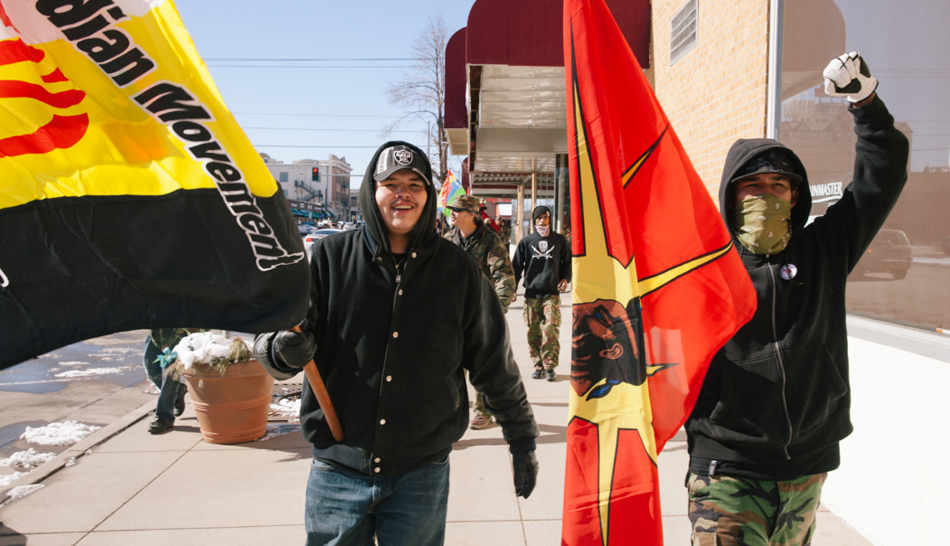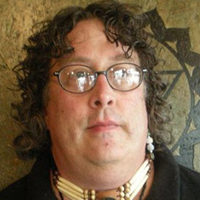
A few weeks ago I talked to Leonard Peltier, American Indian Movement (AIM) member and political prisoner. He asked me to work with Eli Cane, producer of the film On a Knife Edge. After watching it eight times—yes, it’s that good—I fully understand Peltier’s desire for everyone to see this movie.
Eli Cane, 2013 Peabody Award recipient, produced On A Knife Edge, and Jeremy Williams directed. The Normal Life Pictures website summarizes:
“Set against a background of rising tension and protest, a Lakota teenager learns first-hand what it means to lead a new generation and enter adulthood in a world where the odds are stacked against him. Filmed over a five-year period, On a Knife Edge provides a privileged view into the interior world of George Dull Knife as he becomes politically active with the American Indian Movement, confronts the challenges of growing up on the Pine Ridge Reservation, and wrestles with accepting the leadership of his storied family from his aging father.”
The Dull Knife family has a long history dating back to the 1873 Custer massacre. In fact, during the epilogue, George Dull Knife, filmed at the NO-DAPL protest, says, “After the first night, you began to see a caravan of cars driving in. It was like it was during the 1973 occupation. It was the first time in 140+ years all six Council Fires came together,” he states. “The last time that happened was at Custer’s massacre in 1873.”
In 1879 a group of Lakota people including George Dull Knife’s great-grandfather attempted a 600-mile trek back to their homeland after the U.S government initiated a forced removal of tribes to Oklahoma.
Bringing home the harsh reality of the movie is the continuous punishing racism facing reservation life. Many scenes reflect the over 100 years of abuses with colonization and humiliation that Indigenous tribes still face today.
A brutal reality lives out on screen as the Dull Knife family deals with a young sibling’s suicide. During a drunk bender, Mary Dull Knife commits suicide. Suicide is the second-leading cause of death on the reservation for Indigenous youth ages 15-22 years of age. Throughout the film, alcohol is discussed as George Dull Knife lead Oglala Sioux youth to stay away from it.
The Suicide Prevention Center states that the suicide rate for South Dakota young people ages 15 to 24 is double the average rate in the nation, and young American Indian males in South Dakota die from suicide at a rate that is four to five times the national rate.
During a high school class scene, another shocking reality hits home. The teacher discusses income. The average living wage she says in America is $40,000. Her salary as a teacher is $30,000. She then shows a graph reflecting the average annual income for the Pine Ridge reservation as $2,600. This unfair situation is shown quite explicitly within the film.
During class, the teacher even discusses issues surrounding Sioux nation land sovereignty. She shows a map of the Fort Laramie treaty of 1851 “guaranteeing” the land mass given to the Sioux nation. A present day map, however, shows how much of the land has been stolen by individuals, cities and the U.S. government. Some have observed that this situation is eerily familiar to the plight of the Palestinians. “The white people will do anything and everything to keep us down,” George realizes. “The land, that’s what it’s always been about, always, it’s been like that ever since.”
It’s refreshing to see father, Guy Dull Knife, passing on traditional values to his 13 children—especially the significance of the sweat lodge. “It’s important for the kids to know who they are,” Guy states. “I have been using the sweat lodge since age 6,” George stated. (He is mostly 17-18 during the film.) “A sweat lodge is a place of prayer, it’s our way of praying.”
The Dull Knife family has generations of warriors protecting the people of their tribe. Guy instills in all the children the historical aspect, and that frames their present role today. George comes to realize that his great-great-grandfather worked and fought for the people of the tribe. His coming of age within AIM embraces his growth in accepting the Dull Knife legacy.
Several protests are shown with George leading and guiding the youth with the AIM-Grassroots division on Pine Ridge. The film has several scenes with teachings that Clyde Bellecort, co-founder of AIM, shares with the youth. It also has Dennis Banks leading another protest.
George’s coming-of-age tale reflects the necessity to step up and be a warrior for his people. The mechanism for Indigenous people in America is through the American Indian Movement. “All my kids, as they got old enough, were brought up with the importance of AIM,” Guy Dull Knife proclaimed. “They look at it as security for their family and elders of the tribe. Defending our people—children—to ensure they are not hurt.” Guy Dull Knife was part of the 1973 Wounded Knee AIM protests. During the “Reign of Terror” on the Pine Ridge Reservation in the early 1970s hundreds of elders were murdered for following their traditional lifestyle.
“You knock on the door. If they don’t answer you knock harder. If they still don’t answer you knock the damn door down and confront them,” Bellecourt says. He was discussing AIM’s ideas of confrontational politics with the youth.
George shares how it’s always about protecting the people. “All my ancestors did that. It was passed down generation to generation. My dad taught me, my grandfather taught my dad. It’s always been like that.”
The movie is powerful and superbly edited by Eli Cane. It shows the historical abuses the Sioux have suffered and reflects the warrior attitude for the survival of the people. And it shines a light on the younger generation coming into their own within AIM. It also is sad in that most people living in America are unaware of the survival plight of the Indigenous cultures still today on reservations.
Cane says, “When we began the film seven years ago, we didn’t expect to be filming with George for another five years. But this is a far more relevant moment for the film’s release than we could have anticipated.
“As racism and xenophobic rhetoric becomes policy, George’s search for courage and clarity in his struggle has become far more meaningful to audiences everywhere. On a Knife Edge is not an advocacy film; it simply provides a unique opportunity to hear the voices and perspectives of people for whom there are no sidelines; for whom resistance is a birthright.”
On a Knife Edge is edgy, colorful, truthful and eye-opening. This 89-minute movie really should be watched.
No wonder Leonard Peltier is asking all people to see it.










